Archer A7/AX21 2.4G speed for iPhone 11 from 300M Verizon Fios
5* review for successfully resolved my low 2.4G speed problem, excellent support from TP Link and fast 5G speed that exceeds Verizon Fios max speed of 300Mbps.
The purpose of this review is to compare the 2.4G and 5G speeds of the TP Link Archer A7(AC1700) WiFi 5 router and AX21(AX1800) WiFi 6 router using an iPhone 11 which supports WiFi 6. The highest speed I can test is 300Mbps limited by my Verizon Internet plan. Measurement results using show that using the WiFi 5 router, the 2.4G speed is 60M/80M (UL/DL) and the 5G speed is 307M/330M, whereas using the WiFi 6 router, the 2.4G speed is 110M/120M and the 5G speed is about same.
Newer routers’ real life 5G speed is very high and normally is not a problem, but real life 2.4G speed could be slow. It is not entirely sure which part of the wireless link is limiting the 2.4G speed. Below examines the speed limit of the WiFi standards involved, the router and iPhone 11. The routers are TP Link’s Archer A7(AC1700) and AX21(AX1800). Measured speeds at 2.4G and 5G will also be given.
Router (TP Link) Specs and Supported WiFi Standards
1) Archer A7(AC1700) has has 3 antennas is a WiFi 5 router
2.4G : 450Mbps
5G: 1300M bps
Supported Standards: AX21(AX1800) : 802.11ac(Wi-Fi 5), 802.11b, 802.11ax(Wi-Fi 6), 802.11n(Wi-Fi 4), 802.11g
802.11n, 802.11ac, 802.11ax are also called Wi-Fi 4, WiFi 5 and WiFi 6 respectively.
2) AX21(AX1800) has 4 antennas is a WiFi 6 router
2.4G: 574M bps
5G: 1200M bps.
Supported Standards: AX7 (AC1700) 802.11b, 802.11n, 802.11g, 802.11ac
A7 (AX1800) is a low cost ($60) popular (listed as “Amazon Choice”) WiFi 5 router which supports 802.11 ac whereas AX 21 is a low cost ($90) WiFi 6 router which supports 802.11 ax. WiFi 6 (max speed 9.6G) not only has higher speed than WiFi 5 (max speed 3.5G) but also can support more devices using orthogonal frequency division multiple access. The main differences are given in picture 1.
(Picture 1 from : https://www.mwrf.com/technologies/systems/article/21849959/whats-the-difference-between-wifi-5-and-wifi-6)
Comparing the specs of these two routers, one has a higher 2.4G speed while the other has a higher 5G speed. But in real life, according to my measurements, at 2.4G, the WiFi 6 router has almost twice the speed than the WiFi 5 router. I don’t have a high enough wireless speed plan to test the 5G speed. In my house both routers have the same speed of 310M, limited by the max speed allowed by Verizon Fios 300M.
Speeds specified by the WiFi standards are speeds the router manufacturers trying to meet and they are not the limit, but speeds advertised by the router are the speeds that customers want the router to be able to reach. They become upset if they are unable to get the speeds advertised by the router.
Routers often do not specified under what link conditions these seemingly advertised high speeds could be realized. For example what is the required bandwidth, the number of antennas (the so called MIMO) and how pure the signal has to be (the signal to noise ratio). Is the bandwidth 20, 40, 80 or 160M? Is the signal to noise ratio has to be greater than 10dB?
In real life, link speed depends on how far from the router (the signal strength) and radio interference which falls in band (the signal to noise ratio). The former can be solved by doing the speed test right next to the router, where the transmit signal from the router is at maximum. But for the latter, unless one has a so called Faraday Cage, there is no way to block in-band interference especially at 2.4G, which are used by microwave ovens, Bluetooth and many household devices. Interference is hard to quantify without using a spectrum analyzer and could become an excuse if one calls the router support line complaining low speed.
Another limit is the device itself, and in this case iPhone 11. It’s specs are given below.
Wi-Fi specifications for iPhone 11
802.11 standard, name, frequency Maximum PHY data rate Maximum channel bandwidth Maximum MCS index Maximum spatial streams
ax@5 GHz 1200 Mbps 80 MHz 11 (HE) 2/MIMO
ac@5 GHz 866 Mbps 80 MHz 9 (VHT) 2/MIMO
a/n@5 GHz 300 Mbps 40 MHz 7 (HT) 2/MIMO
[email protected] GHz 195 Mbps 20 MHz 9 (HE) 2/MIMO
b/g/[email protected] GHz 144 Mbps 20 MHz 7 (HT) 2/MIMO
(From: https://support.apple.com/guide/deployment/iphone-wi-fi-specification-details-dep268652e6c/web)
https://mcsindex.com gives more details about how the speed on each band is affected by modulation scheme, number of antennas, bandwidth and WiFi standards used, not only for iPhones but for routers as well.
From the iPhone 11 specs, only “n” and “ax” support 2.4GHz if we ignore the older standards “b” and “g”. At 2.4G, The maximum speeds for “n” is 144M whereas for “ax” is 195M. The max bandwidth for both is 20MHz which needs to be set in the router. Setting the bandwidth to 40MHz could lower the speed as the noise power will be doubled.
However, at 5GHz the speed for ac (WiFi 5) is 866M with 80M max bandwidth whereas for ax (WiFi 6) is 1200M also with 80M max bandwidth. These bandwidths should also be specified in the router. Setting the bandwidth too high or too low could lower the speed.
From the iPhone 11 max speeds, it is clear that the wireless link’s speed is not limited by both the A7 and AX21 routers and the standards, but by the iPhone 11 at 2.4G and by Verizon Fios at 5G.
I have Verizon Fios 300M download and upload. Initially, I used an A7, thinking that at 2.4GHz, the router speed is 450M which is higher than iPhone’s 144M(“n”) and 195M(“ax), surely shouldn’t be a problem. But speed test showed that I got only 60M download and 80M upload from the best channel and 20M bandwidth (I tested all the channels and bandwidth combinations).
60M is too slow for me because I have several devices (such as security cameras) using 2.4G. So I called TP Link support line to see what I had done wrong. Most customer supports didn’t know what the problem was the and finally I was connected to a high level support. She said that in real life, I had to multiply the speed by 30-50% and guided me through the various specs of the wireless link. I don’t know where the 30-50% comes from, perhaps it was her empirical experience. If I use the average of 40% and assume that applies to the lower speed of the router and the iPhone, which is 144MHz. 40%x144M is 57M. This was about what I got at 2.4G using the A7 router.
But she also said something about WiFi 6 router and got me thinking perhaps a WiFi 6 router could improve the speed. (I must say that I got excellent support from TP Link, I had gotten calls twice from the specialist unsolicited and many followup emails. All trying to help me solve the low speed problem.)
I then change the A7(AC1700) to an AX21(AX1800), which does support WiFi 6 “ax”.
The main advantage of using AX21 is that it raised the iPhone 11 max speed at 2.4G from 144M to 195M, a gain of 51M. And as a result, in real life, the 2.4G link speed seemed to have increased by about the same amount. Speed test showed that at 2.4G, I now got ~90-110M(download, previously 60M when using A7) and 100-120M(upload) with the channel and bandwidth set on auto. Though the download speed is still less than 195M, the link speed has increased by changing to a router that supports ax and has 4 antennas. Have no idea if a more expensive router will further increase the 2.4G speed.
However, at 5GHz, both routers give 307M download and 330M upload, limited by Verizon Fios max speed of 300M.
When doing speed test, I shut off all 2.4G emitters. I live in a rural area and I suspect there is little interference.
A7 has 3 antennas whereas AX21 has four. Is the speed improvement at 2.4G due to the additional antenna or the support of WiFi 6 or both?


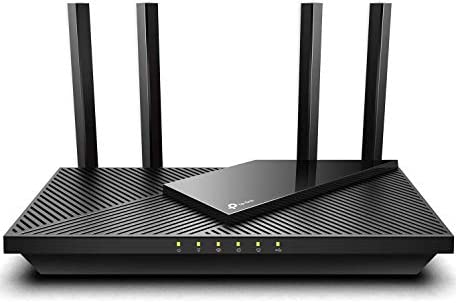
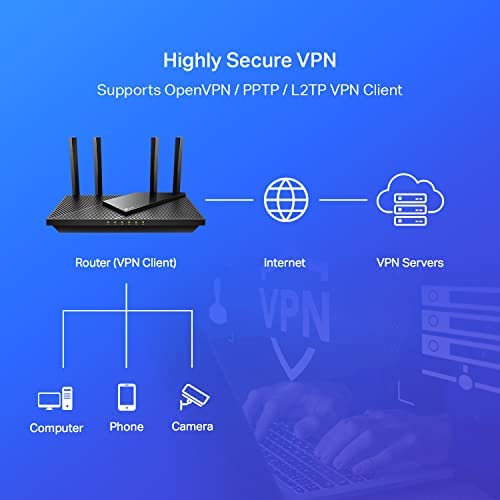
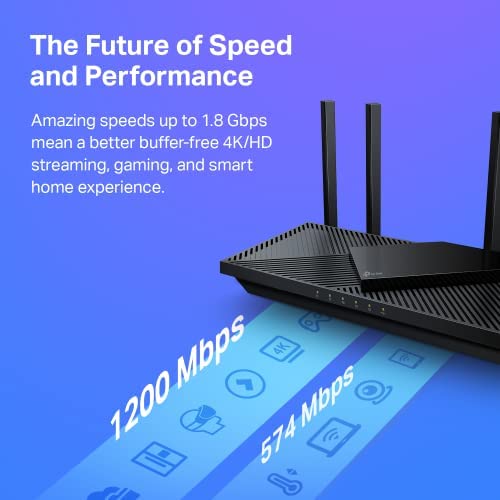
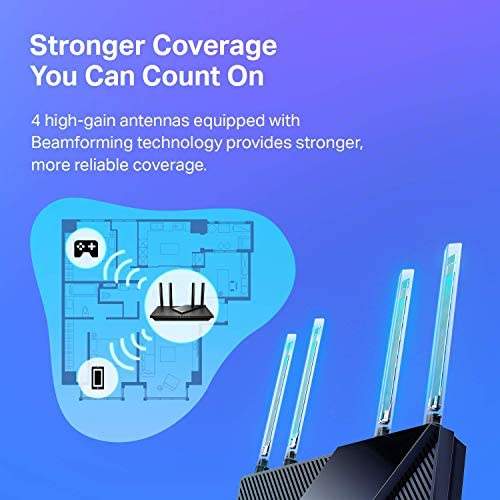

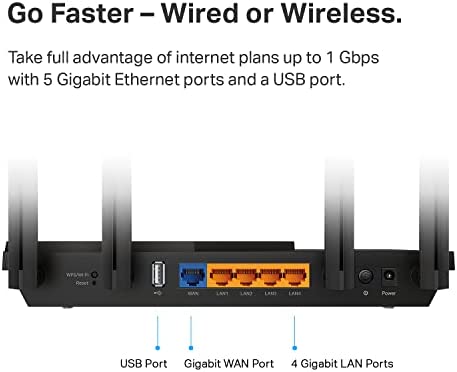












There are no reviews yet.